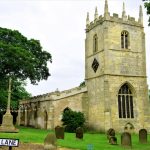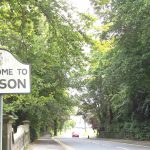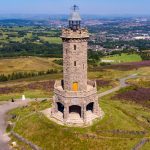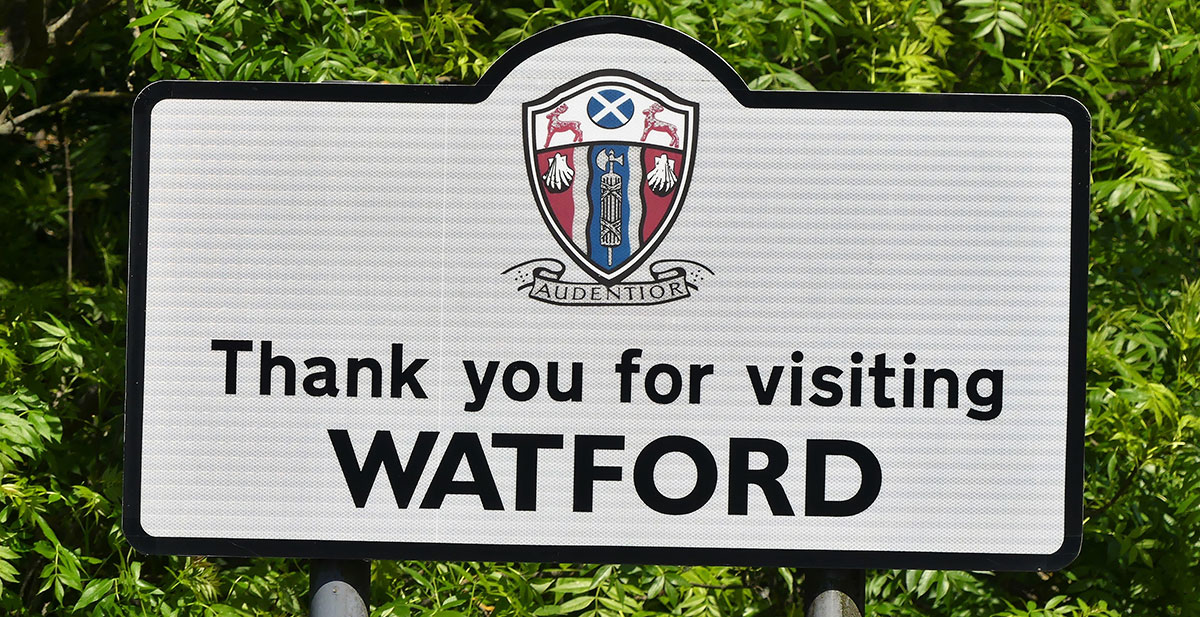
Here at Five Minutes Spare, we take great delight in exploring some of the best staycation destinations that Britain has to offer and the London commuter belt Town of Watford is next on our list. We are on a quest to review the best of British towns from Inverness to Skegness, and Watford is the next map marker we wish to examine. So buckle up and enjoy our quick tour of the place where the North-South Divide begins according to The Government or so it seems.
Watford is situated north-west of London on the River Colne. Throughout the ages, it was best known as being the stately home of the Earls of Essex. Nowadays, however, it is best known for its football team… But the less we say about the 2019/2020 Premier League relegation, the better…
Let’s take an in-depth look into Watford to find out what there is to do there. Is it the ideal place to take your next holiday? Could it be the perfect destination for your Christmas break this year? Let’s find out…
The Early Days of Watford
It is thought that both the Celts and the Romans once occupied the area we now know as Watford. This theory is backed by the naming of the town, which comes from the old English. Historians believe that the word “waet” (meaning watery place) was joined to the word for fjord, to make the name Watford… Which therefore means a fjord across a wetland. This would tie in with the fact that an ancient road runs from the south-east to the north-west, crossing the River Colne.
The Romans would have left Britain in the early centuries, leaving behind a world mostly built out of wood. Many Roman structures therefore perished, but some were taken over by Angles, who eventually built them into stone. Watford was not one of these places. It is mentioned as being claimed by St Albans Abbey in a grant made by King Offa around 793 A.D.
A couple of hundred years after that, Watford is mentioned in an Anglo-Saxon charter. However, in spite of this 1007 mention, it did not receive similar treatment in the Domesday book of 1086. When areas like this were not mentioned, it was usually because they were mostly empty land. In the case of Watford, it was still in the hands of the Abbey at this time.
Watford historians place the settlement as a 12th century emergence. This was when the Abbott chose a site where the market may be placed (that would be of benefit to the Abbey). The same market would still be running in 1928. Despite these 12th century claims, the Watford Museum holds tools cast in flint from the Stone Age, Bronze Age, and even some Anglo-Saxon coins.
A Church and a Market!
We know that St Marys Church was built around the same time as the market was opened. Over time, both the church and the market would be well used by travellers moving north and south from London. The town grew as trade did, eventually attracting the attention of wealthy landowners. By the 16th century, some had already started building stately homes near Watford. This was to (at least in part) to the presence of the Royal Palace at Kings Langley.
Fun Facts About Watford!
Here at Five Minutes Spare, we like to collect all the best gossip about the locations that we research. So whether you live in Watford, or whether you are looking for a British holiday destination with a difference, you can arm yourself with these interesting facts, so you have something to talk about at parties.
- Certain photographic print techniques were developed in Watford during the industrial era. The Rotary Photogravure was used in coloured magazines and supplements of newspapers.
- The only Englishman that ever managed to take the title of Pope came from Abbots Langley. It was in 1100.
- Catherine of Aragon once lived in this area, post-annulment, no less.
- Another legend holds that the owner of Park Mansion was executed in 1685. However, the tale has it that he was whisked away to France and became the man in the iron mask.
- The gardens at Cassiobury Mansion were where Strawberries were first cultivated!
Watford truly is an exceptionally interesting place. It may not be the first place you think of when you think of a summer holiday, but it is chock full of interesting historical facts. Speaking of which, let’s get back to our historical review of this ancient-but-not-ancient town.
16th Century Watford and Later
During the 16th century, Henry VIII was in power. As we mentioned above, Catherine of Aragon moved into this area after she escaped her marriage to him with her head intact. That particular king also managed to close down all the monasteries and abbeys by declaring himself the master of his own religion. This resulted in St Albans Abbey selling Casio and the lands of Watford to the ancestors of the Earls of Essex.
The big house at Cassiobury was built in the 16th century and then rebuilt in the 17th century. Our second fancy house was built nearby and is known as the Grove. The Grove would later become the seat of the Earls of Clarendon. Later this century a toll road was built across the Chiltern hills, which introduced even more business to the area. There is a delightful description written by Daniel Defoe in 1778 wherein he describes Watford as being genteel, but only being a single street long.
The Industrial Years
The Industrial Revolution hit every city and town in Britain in a different way. Prior to the 1800s, Watford was a largely agricultural community with a few manor houses here and there. In 1798 the Grand Junction Canal was built, followed fairly closely by the addition of the railways in 1837. Watford was situated on the London to Birmingham railway line, so it would have been one of the first places to receive a train line.
The Train arrives
That initial railway station was opened for about 12 years before it was closed again, and a larger station was added. This station is still standing to this day and is considered a grade two listed building… Although it houses a used-car lot. The increase of size and train station should be taken as a good indication about the increase in the size of the town. Watford went from being a rural town with one street to being a hub of activity.
Papermaking mills were what made Watford famous. While the rest of the surrounding towns and villages worked with coal, iron, and textiles, Watford made paper. The Coke company had a base here, and the proximity of the Grand Union Canal allowed a gas works to be built. Industrial brewing took place here, and the church was extensively rebuilt at the end of the 18th century. Just before 1850, Watford had a population of around 7000 people. By the time it was 1891 population was 17,063 people.
The railways continued to expand bringing more stations to Watford. Revolutionary engineering works sprang up around town. Factories, steam laundry operators, a cocoa processing plant, and even a cold storage company, made industrial era Watford a terribly busy place.
Before we move on to modern history, let’s revise some of the famous people who have lived in and around Watford over the years.
Famous People From Watford
London and Watford are fairly close together, and that means Watford is used as a commuter town. Therefore, it seems to have a much higher number of famous faces than other cities and towns of the same size. It’s not just who you know what you know – it’s where you live.
The five minutes spare favourite famous people from Watford are:
- Vinnie Jones – this famous (hard as nails) actor was born in Watford.
- Geri Halliwell – that’s right, Ginger spice…
- Bradley Walsh – well-known TV presenter.
- Anthony Joshua – the boxer.
- Olajide Olatunji – a famous YouTuber, is from Watford.
- Gareth Southgate the football manager…
- Mo Mowlam the MP…
And the list goes on. You can actually read it for yourself by following this link.
Modern Watford History
In 1902 there was rioting in Watford when the Crown decided to postpone the coronation of Edward VII. the formative years of the Industrial Revolution had powered great changes throughout the town, but that also caused great slum areas to spring up. There were more people than there was housing. As in many areas of the country, residents in Watford would sometimes be living with whole families squashed into a single room.
Thus the beginning of the 20th-century saw more than just sewage works and electricity being added to the town. Council housing was built, a program that began at the start of the 20th century, paused to account for World War I, and then continued up until the Second World War. Where other towns had already declined by this time, printing centres and Watford didn’t really go into decline until the 1920s. The last press closed in 1978 and the Sun newspaper, a long-standing Watford business, moved on in the 80s.
Watford During the Wars
Watford did not go unscathed during World War I and World War II. Many young men from this area were sent abroad to die in unknown fields. More than 860 Watford men went off to join the service in World War I, never to return home again. The Watford museum runs an exhibit which covers some of their biographies.
During World War II, Watford saw roughly 30,000 children pass through on their way north out of London and away from danger. Watford was heavily bombed. The first victim had a heart attack when she heard the air raid sirens go off. Incendiary bombs were used in the area since the bright lights of Watford would often be mistaken for the bright lights of London. The biggest bombing disaster was on July 31st, 1944, when 37 men, women, and children, were killed. An earlier raid had seen 300 houses damaged – without a single recorded death.
Modern Watford
More recently, furniture was made in Watford in the Hille manufacturing plant. Although it went on to close in 1983. A factory in Leavesden built the Mosquito bomber aeroplane and the Halifax bomber – but was later derelict. It would eventually become the studios where Harry Potter was filmed!
Modern Watford experienced a dip in retail brought about by the recession in the early 00s. Since then, they have seen a fairly steady increase in trade and population alike. Watford is known as a busy town which is just removed enough from the hustle and bustle of London to make for the perfect place to live. It is the kind of place where workers raise their children and teenagers head into the town proper by train on a Saturday. Where mods and rockers once hung out, you will find iPads and Vauxhall Corsa’s. It’s a friendly place and definitely, somewhere you should consider for your next UK holiday.
What To See And Do In Watford?
Watford is home to more than a handful of cool attractions. Whether you are in town overnight, or whether you intend to stay for a few weeks, you will find no shortage of excellent fun to be had. Here are some of the five minutes spare favourite things that you can get up to when you are in town. Add them to your travel itinerary and be sure to have fun!
Historic Sites And Landmarks
There are a number of big houses in the area that you can go and enjoy. Check out Cheslyn House and gardens as a firm favourite, they have 3 ½ acres with a pond, aviary, and even a fernery for you to peruse. This house was designed by the famous architect Henry Colbeck and his wife, Daisy. The garden is open for different time periods throughout the year, so be sure to check before you go.
Alternatively, you can head to Bhaktivedanta Manor. This is something a little bit different and is actually a temple. It is a beautiful old building which houses the UK Hare Krishna movement. This is where the movement was birthed back in 1973. This estate was donated to them and remains a thriving and important part of their belief system to this day.
Head over to Lincolnsfield centre on a Sunday if you would like to take part in the 40s experience. Although not technically a historic site or landmark, this is an immersive historical adventure that lets you experience what life would be like during the Blitz… Among other things.
For those who like to go on pilgrimages while they’re on holiday, you should try visiting Oxhey Chapel. Run by the Churches Conservation Trust, this is a designated grade 2 listed building that was built in 1612 as a private chapel for Sir James Altham and his family. It is thought to have been built on the ruins of a monastery.
Sports Teams
Watford football club was made famous in 1976 when Elton John (now sir) was club chairman, has been a lifelong fan. Despite the recent relegation in recent years the club has been a regular in the top two flights of English Football and often enjoys a good cup run. If you fancy watching a game when in town stop in at their Vicarage Road stadium.
Of course, not everyone likes football. If rugby is more your thing, Watford rugby club routinely play in town. There are also several golf clubs in the area, some of which have refined country clubs attached. There are actually so many around Watford that we are just going to refer you to Golf Now, who will give you the tee times and opening hours.
Outdoor and Recreation
For a fun day out and a free thing to do in Watford, head to the award-winning and historically relevant Cassiobury Park. They have paddling pools, water features, a bandstand, a café that is open all year round, and an ongoing programme of activities to engage in. The park is particularly busy in the summer months and the weather is good, being a much loved local hotspot for sunbathers.
While you are out in Oxhey visiting the church, you may want to take a stroll through the woodland there. Oxhey woods is Watford’s answer to a nature reserve, making a great space for locals to walk, mountain bike, or even camp. There are sculptures hidden throughout the woods, so make a game of it and try to find them all.
Another outdoor attraction you should check out is the National animal welfare trust. It’s a rescue and rehoming centre that could really use your help. If you fancy coming back from your holiday with a new pet, as many people are at the moment, this place may be able to help you out. They don’t just rehome; they also have parts of the centre devoted to educating children about animals.
If you visit should happen to coincide with the spooky season, consider an after dark meander around the Vicarage Road cemetery, or St Mary’s churchyard. It’s the ideal place for a Halloween visit!
For something less macabre, take the kids to the Manor house sports and social centre to indulge in some fun and games. Similar fun can be had at Harwoods Adventurous Playground. There are loads of things to do in Watford with children.
Museums and Galleries
The Watford Museum is home to almost all of the history regarding the town. If you’re trying to trace our ancestry, this would be a good place to start. The museum is interesting in itself because it is set in an old brewery. The Watford museum displays a few works of art, too.
While you are enjoying the 40s experience out on Bushey, you can check out the museum on the ground there. This one includes a small art gallery and goes into more depth in some of the art history from the area. It is also filled with historical documents, artefacts, and archaeology.
If you are looking for art that you can buy and take home with you, visit Toulla Fine Art for all manner of goodies. Let’s support small businesses while we still can.
Shopping and Retail
Watford has several decent areas for shopping, keep in mind you aren’t that far from London if you want more choice. Visit Watford market for your more basic necessities or head into Intu Watford for the full-on American shopping mall experience.
Other Points of Interest in Watford
There are a few attractions in Watford that don’t really fit into any category. The Pumphouse Theatre springs to mind as a place you should definitely investigate while you are in town. They regularly run interesting shows and act as a hub for emerging talent. If you want a more opulent theatre experience (including the bigger London shows) then you should try the Watford Palace Theatre instead.
The last point of interest is the Watford Colosseum. Although not technically a theatre, it is one of the best-known performance venues for miles around. There are tons of other great things to see and do in Watford, we simply don’t have space for them all.
Where to Eat, Drink, and Party, In Watford?
For a late lunch, consider Eats and Treats on St Albans Rd. We have it on one reviewer’s authority that the coffee cake is amazing. For a family feast, the Turkish Derwish Meze & BBQ restaurant gets rave reviews, too. If you want to party hard and need cocktails to start the night off, Bar Bodega has a great reputation. However, if you are looking to party the night away into the small hours of the morning, try PRYZM.
How to get to Watford?
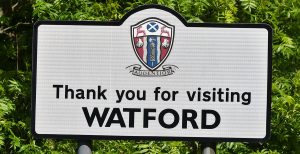
Image: Peter_Fleming/Shutterstock.com
We have just about covered everything there is to know about this lovely town, but we can’t leave you without telling you how to get there… That would be counter-productive.
By Road
Head out of London on the M1 and you will eventually find Watford.
By Rail
Watford Junction is the most central train station and is on the London north-western Railway service.
By Air
You are reasonably close to all London airports, however, London Heathrow is nearest.
By Sea
You may sail up the River Colne, but Watford has no sea access.
Not the right Staycation Destination for you?
If you really want to go on holiday, but 2020 has you grounded, we have all manner of destinations already detailed over on our UK pages. Don’t forget you can follow us on Instagram for more. Everyone is in desperate need of a holiday this year… Don’t let a global pandemic stop you from having yours.

